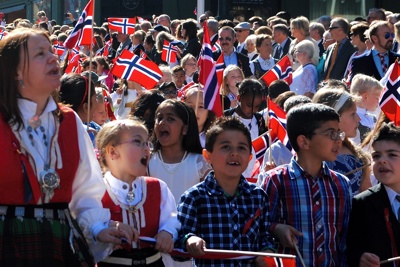Norwegians and “new Norwegians” alike marched side-by-side again in parades Saturday on what the locals call “17.mai,” the Constitution Day holiday on the 17th of May. It’s the one day of the year when many immigrants actually feel included in Norwegian society, a surprising discovery in a new study that researchers link to a “17th of May paradox.”

For all its lavish displays of patriotism (some might say nationalism), the 17th of May has been embraced by an overwhelming majority of immigrants in Norway. Fully 80 percent of those responding to a survey on Norway’s constitution as a national symbol (Grunnloven som nasjonalt symbol, conducted by the research foundation Stiftelsen Kirkeforskning, KIFO) said they agreed with a statement that it was “important to celebrate the 17th of May.” Nearly 90 percent said they celebrated the holiday, and around 60 percent took part in public events like parades and street parties, participation rates by immigrants that are much higher than on many other countries’ national days.
KIFO researchers contend that the response rate of those positive towards the 17th of May is a strong indication that most of the immigrants take part in public celebrations of the national holiday not because it’s expected of them, but because it means something to them and their role in society. The researchers think it means that the 17th of May has become an important symbol of the new “multicultural Norway,” but note that the reasons for embracing the holiday vary between immigrants and what the researchers call “ethnic Norwegians.”
Nordic immigrants participate less
The survey was conducted among Norwegians in general but included a supplement that questioned 750 residents who were not born in Norway or had parents who were born outside Norway. “We then divided them up into immigrants from other Nordic countries, from other western countries and from non-Western countries,” stated Olaf Aagedal and Pål Ketil Botvar, researchers at the Norwegian foundation KIFO, in a commentary published by Norwegian Broadcasting (NRK) in which they shared research results.
Interestingly, it was the immigrants from other Nordic countries who had a lower degree of participation in 17th of May celebrations than the other immigrant groups. Some Swedes, many of them work migrants in Norway, have been quoted in local newspapers recently as saying they “escape” all the Norwegian flag waving on the 17th of May and head home for the holiday.
Aagedal and Botvar raised the question themselves of whether immigrants see themselves as participants or spectators on the 17th of May. Their answers indicated the former, because many also replied they feel more included among ethnic Norwegians on the Constitution Day holiday. While there was controversy 20 years ago at the site of an immigrant wearing a Norwegian folk costume (bunad) or leading a parade, it’s now become common, and Norwegians themselves tend to be more open and inclusive on their national day.
The ’17th of May paradox’
“This is the 17th of May paradox, that Norwegians often behave differently on the day than they do the rest of the year,” Aagedal and Botvar wrote. “It’s a people’s party and Norwegians are open and inclusive towards people they don’t know.” In short, most Norwegians seem friendlier and proud to share and promote their country on their national day.
At the same time, the “street party” atmosphere on the 17th of May is more familiar to people from other parts of the world where large “people’s parties” are more common throughout the year. As one young man from Pakistan told newspaper Morgenbladet last year, “it’s a day when Norwegians can speak openly with foreigners, and it’s a nice atmosphere. For Mamma, the 17th of May is when Oslo’s streets become like streets in Punjab. It’s a day when she really feels at home.”
The researchers cited expressions of fellowship and joy on the 17th of May that were common to both the immigrants and the Norwegians they questioned. The Norwegians expressed more pride over Norway, but the children of immigrants now also take active part in their schools’ special events and march in parades. The researchers noted that the role played by the schools in 17th of May events, and the concrete roles assigned to immigrant children and their parents alike add to their feelings of fellowship and pride. Racial conflicts from the early 1980s have subsided and since 2008, four of the six leaders of the 17th of May Committee in Oslo have had minority background. “The celebrations have become an important symbol for a multicultural Norway,” the researchers wrote.
newsinenglish.no/Nina Berglund

